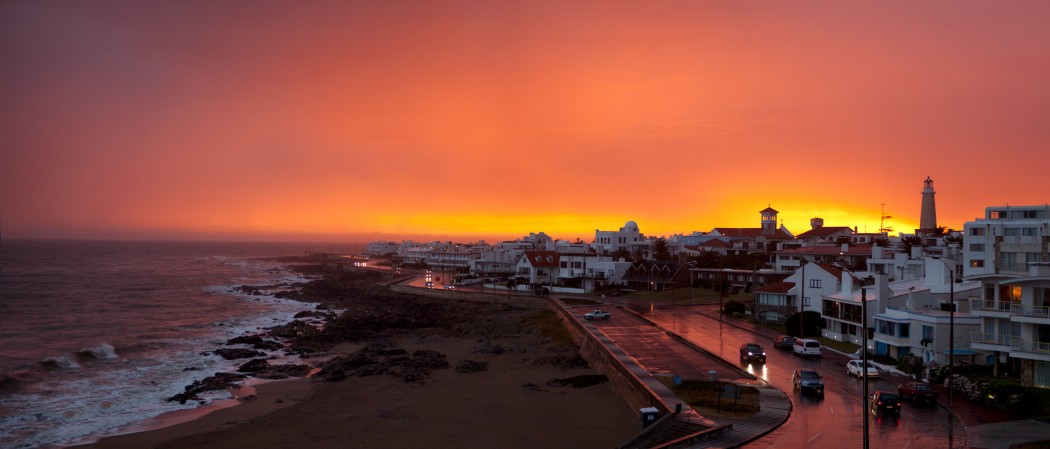Describen al balneario como un lugar “donde los días se despliegan de acuerdo a los ritmos latinos. La gente saborea los últimos momentos de la puesta de sol y van a cenar a las 10”La revista Forbes invita a sus lectores norteamericanos a que en el «próximo invierno se hagan una escapada a Punta del Este».Describe al balneario estrella como el lugar donde “adinerados porteños” comenzaron a construir sus casas de verano hace más de un siglo. Pero ahora resalta también la presencia de brasileños que eligen el destino “atraídos por la seguridad”.Si bien hablan de un lugar donde se junta el jet set internacional, el cronista resalta que es un lugar “casual”.“La arena es tan suave como lo es en cualquier parte del mundo, y las playas se extienden por kilómetros y kilómetros. Pero el atractivo no es solo el lugar, sino con quién estás compartiendo. Es fácil para los norteamericanos viajar dentro de nuestra pequeña burbuja. Yo prefiero a salir de ella, de encontrarme en un lugar que no gira con nosotros, donde alrededor hablan inglés, pero no es la lengua franca, y donde los días se despliegan de acuerdo con los ritmos latinos. La gente saborea los últimos momentos de la puesta de sol y van a cenar a las 10. La fiesta continúa toda la noche”, describe el cronista.Además hablan de una temporada intensa pero breve desde Navidad hasta mediados de enero. Igualmente, a pesar de que la cantidad de turistas sea menor luego de esa fecha, invita a que la gente se quede ya que “Punta del Este sigue siendo seductora”.»Es verano por dos meses más, muchos restaurantes están abiertos, el mar está más caliente, y las tarifas hoteleras bajan», agrega.No solo se destacan algunos grandes hoteles sino también la vida social, las galerías de arte, los “excelentes restaurantes”, las tiendas de antigüedades de La Barra y los atardeceres de Manantiales. A su vez, invitan a probar el caviar uruguayo, “considerado el tercero mejor del mundo”.En la publicación no se olvida de nombrar a José Ignacio, lugar que describe como “un pueblo de pescadores de unos pocos cientos de personas y ahora capital cool de la región, con las más magníficas playas de arena blanca y tres establecimientos de alto lujo, hoteles de arte con visión de diminutas Estancia Vik, Playa Vik y, finalmente, el tan esperado Bahía Vik”.NOTA COMPLETA FORBES:
“The Hamptons of Buenos Aires” is the easy shorthand for Punta del Este, a reference to the fact that well-off Porteños started building their summer retreats here a century ago. But I prefer the “St. Barth of South America,” as this sunny, sandy sliver of Uruguayan coast is now also a magnet for Brazilians, drawn by the safety, plus a smattering of international jet-setters. It’s also more casual than most millionaires’ playgrounds—I’ve never taken “barefoot luxury” so literally: At two prestigious establishments here, I followed the lead of other guests and kicked off my shoes at the door.
The sand is as soft as it is anywhere in the world, and the beaches stretch for miles and miles and miles. But the appeal isn’t just the place, but whom you’re sharing it with. It’s easy for North Americans to travel inside our own little bubble. I prefer to pop out of it, to find myself in a place that doesn’t revolve around us—where English is spoken but not the lingua franca, and where days unfold according to Latin rhythms. People savor the last moments of the sunset and go to dinner at 10. The party goes all night.
The season is intense but brief: Between the days before Christmas and mid-January, the population of Punta del Este swells from about 15,000 to 250,000. But although that crazy social swirl is starting to wind down, Punta del Este remains beguiling. It’s summer for two more months, many restaurants are open, the ocean is warmer, and hotel rates go down.
The community’s cultural ambassadors are also working to extend the appeal. Gabriel Bialystocki has organized the Punta del Este Food & Wine Festival during South American spring for the past four years, and he’s doing a summer edition for the second half of this month, with local stars and chefs from around the world, including Ben Ford from Los Angeles. And respected Paris-based art dealer Renos Xippas is hanging out his shingle here—with an international stable of artists including Vik Muniz and Vera Lutter—and sat on the selection committee for the inaugural edition of the ESTE Arte, last week, an international contemporary fair with two dozen galleries, all set on proving that there’s more going on here than cheap and cheerful beach-house art.
And one major hotel operator, the family behind the comfortable and convenient Buenos Aires Grand Hotel, has just doubled down on making Punta del Este easy for American visitors. At their new Punta Grand, the design is fantastic, with the hotel made largely of glass and shaped like an ocean liner so that almost all of the 120 rooms have ocean views. (Ask for an oceanfront room to get a 180-degree sea panorama through curved windows.) There’s beach service on the stretch of Brava Beach just across the street, large indoor and outdoor heated pools, a good-size gym, a spa and the Mediterranean-tinged Lighthouse restaurant, whose Italian chef came from Cipriani. And although visitors here are generally encouraged to rent a car, the hotel has an on-demand private shuttle service.
That’s important, because there’s more to Punta del Este than just the point and the big city. The social life, art galleries and excellent dining are spread through a string of boho-chic fishing villages up the coast. Nearly an hour out is Garzon, home to superstar chef Francis Mallmann’s restaurant and hotel of the same name, which helped put the area on the map, and inspired the cooking of virtually every other chef in the region.
Closest to the city is La Barra, which is full of antique shops and home to the excellent Fasano restaurant in the small Fasano resort (an outpost of the excellent Brazilian brand). The views, from one of the highest points in the area, are spectacular, and the Italian food is superb. Go early enough to watch the sunset from the outdoor lounge, and splurge on the local caviar, considered the third-best in the world.
Next out is Manantiales, which is more oriented toward concept stores and laid-back gourmet restaurants, such as the popular O’Farrell and the homestyle El Almacén Casa de Alimentos, where much of the food is cooked on a small grill out front. Art is flourishing here too, with the Galeria del Paseo in town and Fundación Pablo Atchugarry, a sculpture park created by one of Uruguay’s most prominent artists, up the road.
Further still is José Ignacio, recently a fishing village of a few hundred people and now the region’s capital of cool, with the most magnificent white-sand beaches and three tiny high-luxury, art-forward hotels, Estancia Vik, Playa Vik and finally the much-anticipated Bahia Vik, which opened last month. Here’s where to go to sunbathe and have a leisurely lunch among beautiful people. More than a dozen years after opening, the beachfront La Huella is not only still the epicenter of the scene—book well in advance—but also an accomplished restaurant serving top-notch sushi, South American-style grilled meats, homemade bread and vegetables from nearby organic farms. But the brand-new La Susana, at Bahia Vik, is poised to give it a run for its money.


